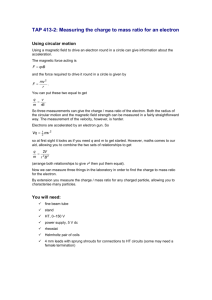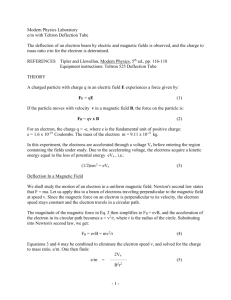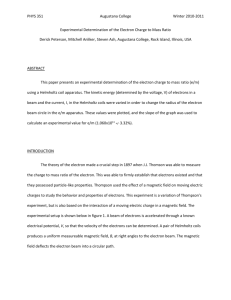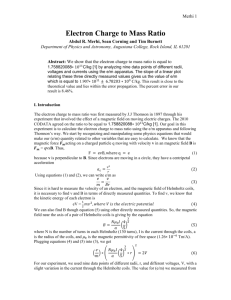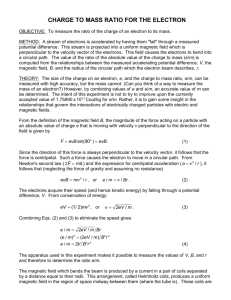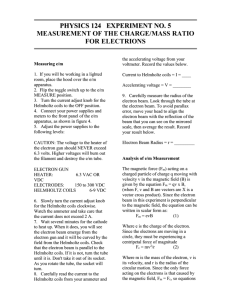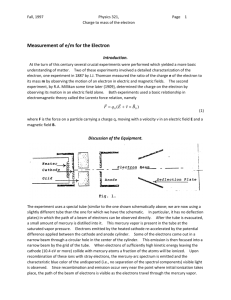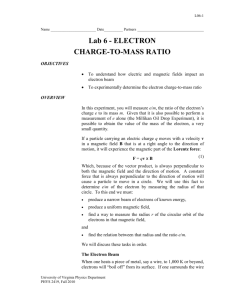Physics 340 - SharedCurriculum
advertisement
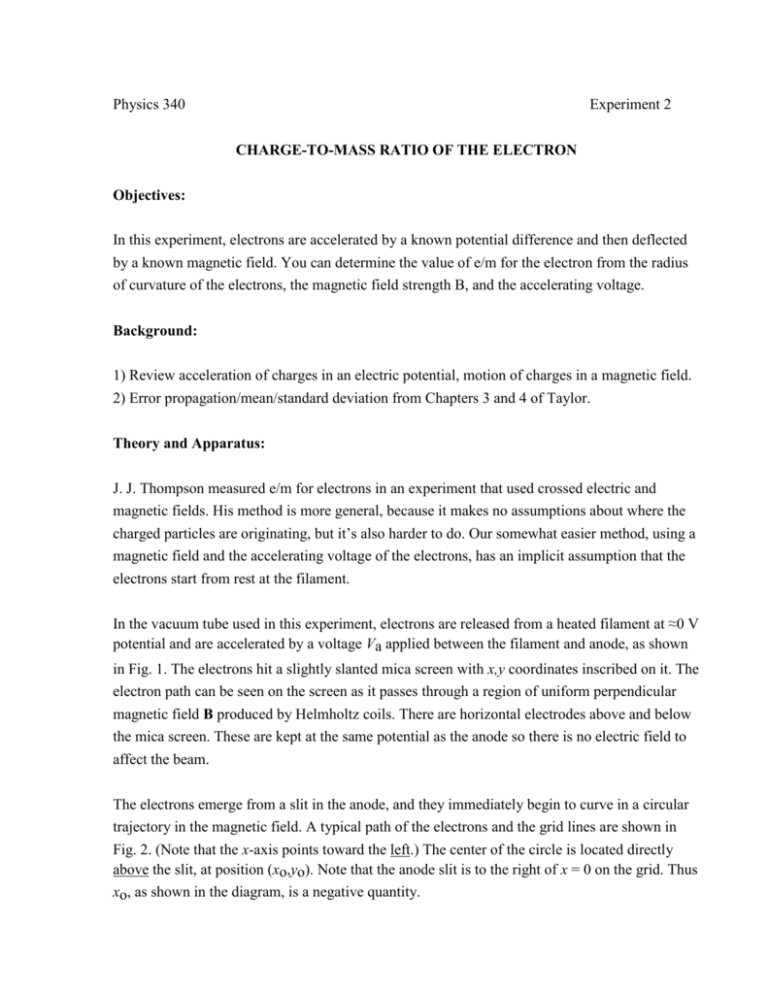
Physics 340 Experiment 2 CHARGE-TO-MASS RATIO OF THE ELECTRON Objectives: In this experiment, electrons are accelerated by a known potential difference and then deflected by a known magnetic field. You can determine the value of e/m for the electron from the radius of curvature of the electrons, the magnetic field strength B, and the accelerating voltage. Background: 1) Review acceleration of charges in an electric potential, motion of charges in a magnetic field. 2) Error propagation/mean/standard deviation from Chapters 3 and 4 of Taylor. Theory and Apparatus: J. J. Thompson measured e/m for electrons in an experiment that used crossed electric and magnetic fields. His method is more general, because it makes no assumptions about where the charged particles are originating, but it’s also harder to do. Our somewhat easier method, using a magnetic field and the accelerating voltage of the electrons, has an implicit assumption that the electrons start from rest at the filament. In the vacuum tube used in this experiment, electrons are released from a heated filament at ≈0 V potential and are accelerated by a voltage Va applied between the filament and anode, as shown in Fig. 1. The electrons hit a slightly slanted mica screen with x,y coordinates inscribed on it. The electron path can be seen on the screen as it passes through a region of uniform perpendicular magnetic field B produced by Helmholtz coils. There are horizontal electrodes above and below the mica screen. These are kept at the same potential as the anode so there is no electric field to affect the beam. The electrons emerge from a slit in the anode, and they immediately begin to curve in a circular trajectory in the magnetic field. A typical path of the electrons and the grid lines are shown in Fig. 2. (Note that the x-axis points toward the left.) The center of the circle is located directly above the slit, at position (xo,yo). Note that the anode slit is to the right of x = 0 on the grid. Thus xo, as shown in the diagram, is a negative quantity. Physics 340, Experiment 2 Page 2 Figure 1 - Experimental arrangement. The general equation for a circle of radius r centered at (xo,yo) is: r 2 x x 0 y y 0 2 2 (1) Figure 2 - Details of electron trajectory. For an electron accelerating voltage Va, conservation of energy gives: 1 2 mv 2 eVa (2) For an electron moving perpendicular to a magnetic field B, the magnetic force evB supplies the force that results in the centripetal acceleration for circular motion: Physics 340, Experiment 2 m v2 Bev or mv Ber r Page 3 (3) If relativistic velocities are involved, Eqs. 2 and 3 must be replaced by: 1mc2 eVa (2’) mv Ber , (3’) and where = 1/(1 – v2/c2)1/2. Combining Eq. 2 and Eq. 3 yields: e 2V 2 a2 . m Br (4) This is the main result you need for analysis of the experiment. Helmholtz coils are a pair of facing coils, each of diameter D and current I, such that the spacing between the coils equals their radius. It can be shown that Helmholtz coils produce a very uniform magnetic field over an extended region in the center, and for this reason they are widely used in laboratory applications. The value (in tesla) of the magnetic field produced by the Helmholtz coils at their center and midway between them is: B 160 NI 125 D (5) where N is the number of turns on each coil and µ0 = 4 10–7 N/A2 (N = newtons in this case). that D must be in meters, not centimeters! Note Procedure: Physics 340, Experiment 2 Page 4 General note: In this experiment, and others, you should read each step in the procedure completely before starting to do the step. There is often information toward the end of the step that you need to know to carry out the step successfully. Caution: High voltages up to 3000 V are used in this experiment. 1. Measure the mean diameter D of the Helmholtz coils and estimate your uncertainty D. Note the number of turns N on your coil (it’s written on the wooden base of the coil) and record it. Follow the wiring to see how the current from the coil’s DC power supply passes through the current meter and the reversing switch. Then • • • • Open the reversing switch (middle position). Turn the two current control knobs, coarse and fine, and the two voltage control knobs on the magnet’s power supply fully counterclockwise. Turn on the power supply. Turn the voltage knob to set the voltage at 5 V. Close the reversing switch. Slowly turn the current knob and watch the digital meter to see the current I going to the coils. Set the current to roughly 0.5 A. 2. The General Radio power supply heats the filament in the electron gun. Turn it on. Set the voltage on the separate high voltage supply to "0" and then turn it on. (Note that the voltage is the sum of the three dial readings. It is accurate to about V ≈ 1 V). Turn the high voltage up to 2000 V. You should see the electron beam curving upward or downward. Reverse the magnetic field switch and the deflection should reverse. Now open the switch so that no current flows to the coils. The electron beam should go straight ahead, but close observation may show that the beam is not exactly level along the x-axis of the grid. (This could be due either to the earth’s field or to misalignment of your tube.) If the beam isn’t right along the axis, you’ll need to correct for this. With the magnetic field off, record the y-value of the center of the electron beam at the positions x = 2, 4, 6, 8, and 10 cm. The grid lines are spaced every 0.2 cm, and you should estimate the position to the nearest 0.05 cm (one-quarter of the grid spacing). Call these values yoffset. If the beam is below the axis, record yoffset as a negative value. You’ll need to subtract yoffset from your each of your later measurements to correct for the zero-field deflection of the electron beam. 3. Now close the reversing switch to make the beam deflect upward. Reduce the high voltage to Va = 1000 V. Adjust the magnetic field (by adjusting the current) to make the center of the beam pass as exactly as possible through the point x = 10.0 cm, y = 2.0 cm. This is a reference point Physics 340, Experiment 2 Page 5 you’ll use in subsequent measurements. Record the current I and estimate I. Then read and record the electron beam position y1 at x1 = 2.0 cm, y2 at x2 = 4.0 cm, y3 at x3 = 6.0 cm, and the position y4 at x4 = 8.0 cm. Estimate to the nearest 0.05 cm. You’ve already set y5 = 2.0 cm at x5 = 10.0 cm, so you have five points on the trajectory. 4. Reverse the field switch. Due to slightly different resistances in the switch, the current may not be exactly the same as it was before reversing. If needed, adjust the current to the current value you recorded in Step 3 so that you have an exactly reversed field. Then record the positions y1´, y2´, y3´, y4´, and y5´ at x1 = 2.0, x2 = 4.0, x3 = 6.0, x4 = 8.0, and x5 = 10.0 cm. 5. Repeat Steps 3 and 4 for anode voltages Va = 1500, 2000, 2500, and 3000 V. You don’t need to redetermine the offsets, but you do want to make sure you have y5 = 2.0 cm at x5 = 10.0 cm for all voltages. When done, you’ll have 5 points on the trajectory for each of 5 different anode voltages. Analysis: 1. Correct the data by subtracting the yoffset values you found in Step 2. (You subtract for both the upward and downward deflection data.) Your corrected values now represent the deflection due just to the applied field. After correcting the values for any offset, you should see that the y and y´ values at each x are nearly, but perhaps not exactly, the same except for their sign. These up and down trajectories should be mirror images of each other in an ideal tube, but you may have differences due to the fact that the anode slit is not aligned exactly on the x-axis of the grid. You can correct for this by averaging the absolute values of your upward and downward deflection data. (Averaging 0.95 cm and 1.05 cm to get 1.0 cm is equivalent to saying that the electron beam is 0.05 cm too high.) Observe your data carefully to see that averaging shifts the values of y1, y2, y3, y4, and y5 all by about the same amount. If one is distinctly different from the others, it suggests that you misread one of the position values (or one of the offsets). After correcting for offsets and then averaging, you have five well-defined positions on the electron’s trajectory for each of the five different anode voltages. 2. You need to determine the radius of curvature of the electron beam. Eq. 1 gives r, but only if you first know x0 and y0. But you don’t know x0 and y0. However, you do know five (x,y) points on each trajectory. Use your MATLAB code from Lab 1 to fit a circle to the five data points for each anode voltage. You will have to rearrange Eq.1! Remember that MATLAB also provides you with the error estimate r. You should get a separate r and r Physics 340, Experiment 2 Page 6 for each voltage. Note that MATLAB reports the r value corresponding to a 95% confidence interval. Use the MATLAB command confint(fittedmodel,0.6827) to get the 68% confidence intervals which match the rest of your uncertainties (where ``fittedmodel” is the output of your fit function). 3. Derive a formula using Eq. 4 and 5 for e/m in terms of the measured quantities Va, D, N, I, and r. Before you go any further calculate e/m for Va = 1000 V. It should be close to the accepted value of 1.761011 C/kg. If not, check your formula, the units of your quantities, and your calculations. 4. Write a MATLAB code to do all the calculations for both e/m and the uncertainty (e/m) (Look at number 5 for the uncertainty). Your code should calculate e/m for each anode voltage, then take the average of your five values. Record the five values for e/m, the five (e/m), and the average value of e/m. 5. The uncertainty in your average e/m can be estimated two ways. First, you can simply calculate the standard deviation of your five values of e/m. Second, you can compute (e/m) for each value of e/m by using the equation below: 2 2 2 æ dVa ö æ d (e/m) ö ædI ö æ dr ö æ dD ö = + 4 + 4 + 4 ç ÷ ç ÷ ç ÷ ç ÷ ç ÷ è e/m ø èI ø èrø èDø è Va ø 2 (6) and then find the average uncertainty. Ideally, these two numbers should be very similar. If they differ by much, either you mis-estimated the uncertainties or you have a systematic error somewhere. In either case, use the larger of the two uncertainties. Then divide by (5)1/2 to get the standard deviation of the mean. 6. Use the error propagation methods in Chapter 3 of Taylor to “prove” that Eq. 6 is correct. 7. Report your final experimental value of e/m in the form value ± uncertainty. Compare your result with the accepted value of 1.761011 C/kg. Note: Keep a record of your value of e/m and its uncertainty in your lab notebook. You may need this value for use in Experiments 2 and 3 before you get your lab report back. Additional Questions Physics 340, Experiment 2 Page 7 1. Calculate the speed of an electron accelerated from rest through a potential difference of 2000 V. Then calculate the magnetic field strength in which this electron would have a radius of curvature of 35 cm. 2. Calculate from Eq. 2’ for an electron accelerated by an anode voltage of 2000 V. Do we need to use the relativistic equations in our experiment? If not, why not? If so, find the relativistic correction and determine a new value of e/m for at least one value of Va. 3. A current loop creates a magnetic field. Consider a current loop of radius R with current I. Let the z-axis pass through the center of the coil, perpendicular to the plane of the coil. The magnetic field B at a distance z along this axis through the center of the coil can be shown to be 𝜇𝑜 𝐼𝑅 2 𝐵 = 𝑗𝑙𝑎𝑗𝑙𝑠𝑗𝑓𝑙𝑗 2(𝑅 2 + 𝑧 2 )3/2 Use this result to derive Eq. 5 for a Helmholtz coil. 4. Calculate the magnetic field of the Helmholtz coil for the current you used for Va = 2000 V. Is your calculation in reasonable agreement with your answer to the first question above? The earth’s magnetic field is ≈510-5 T, and its horizontal component is roughly half of this. Is the earth’s field likely to affect your experiment? If so, did your procedure take this into account?
